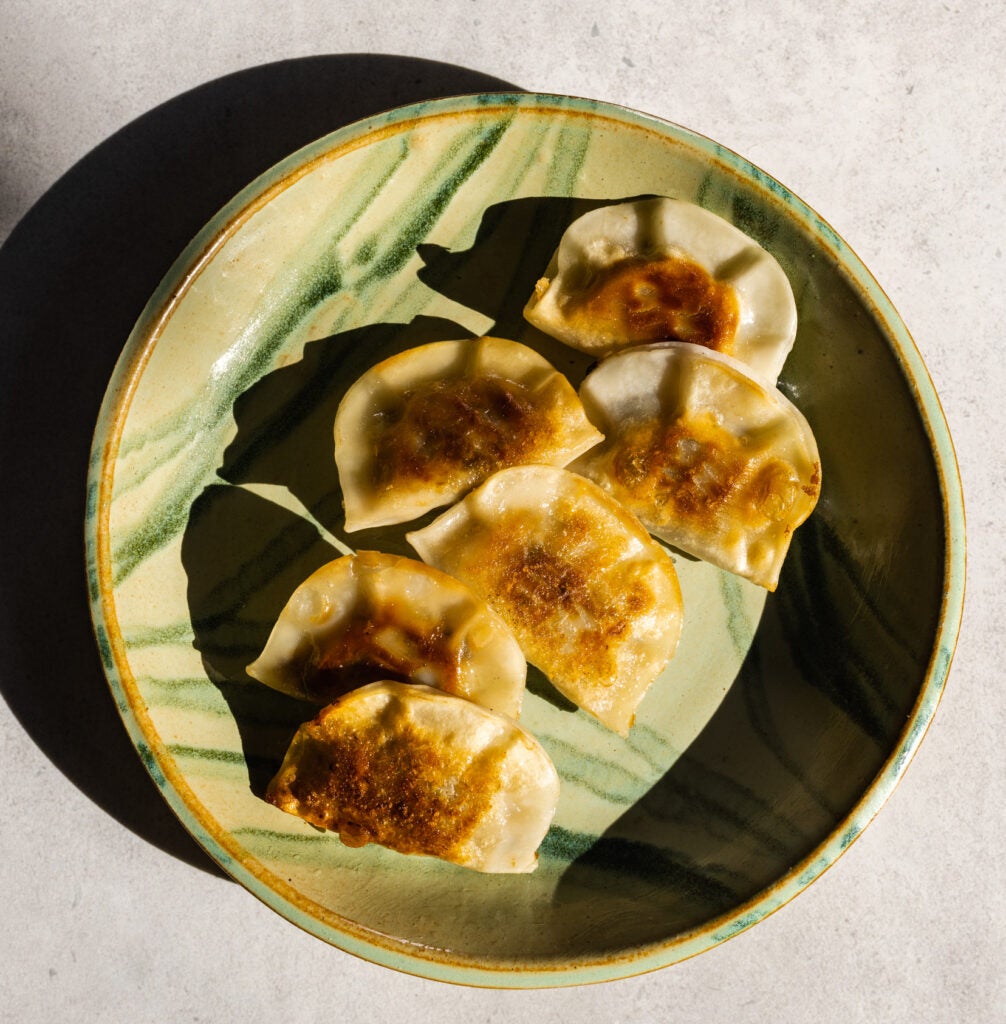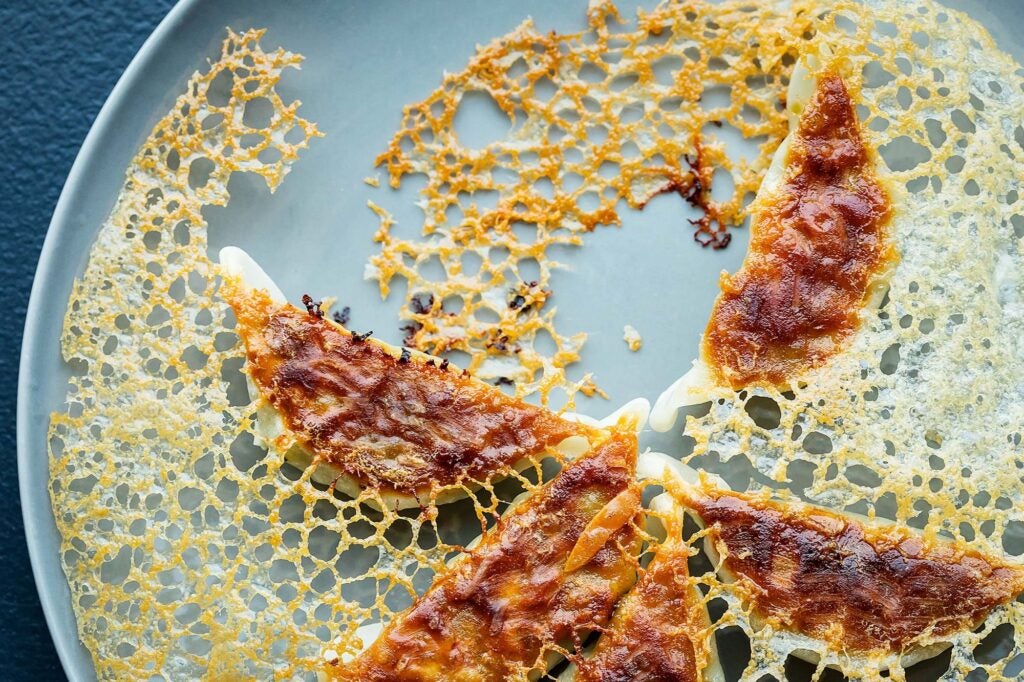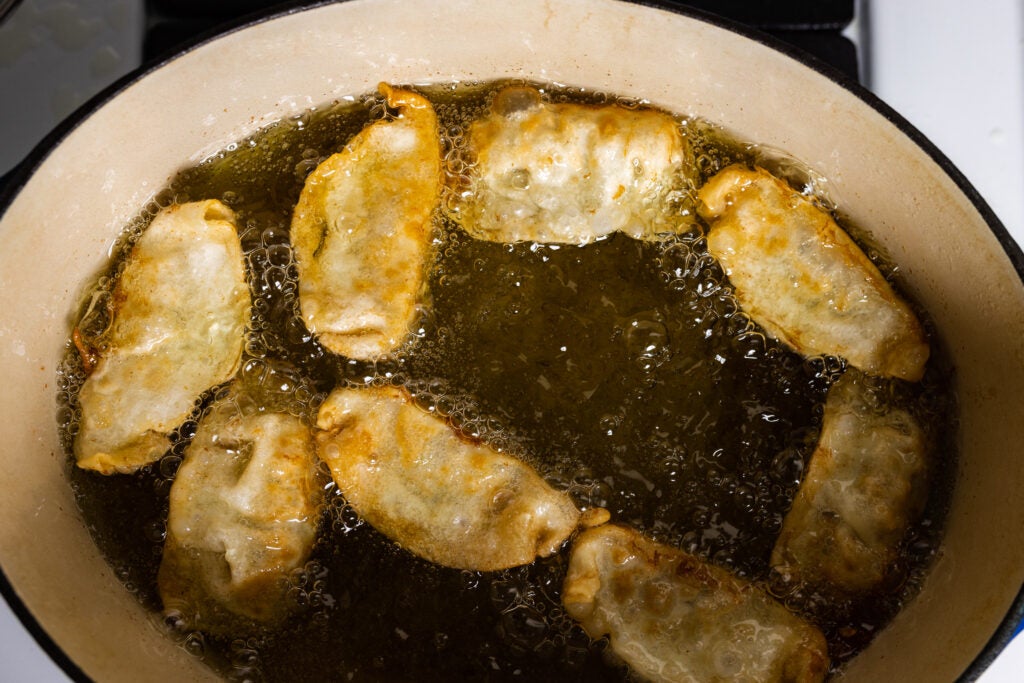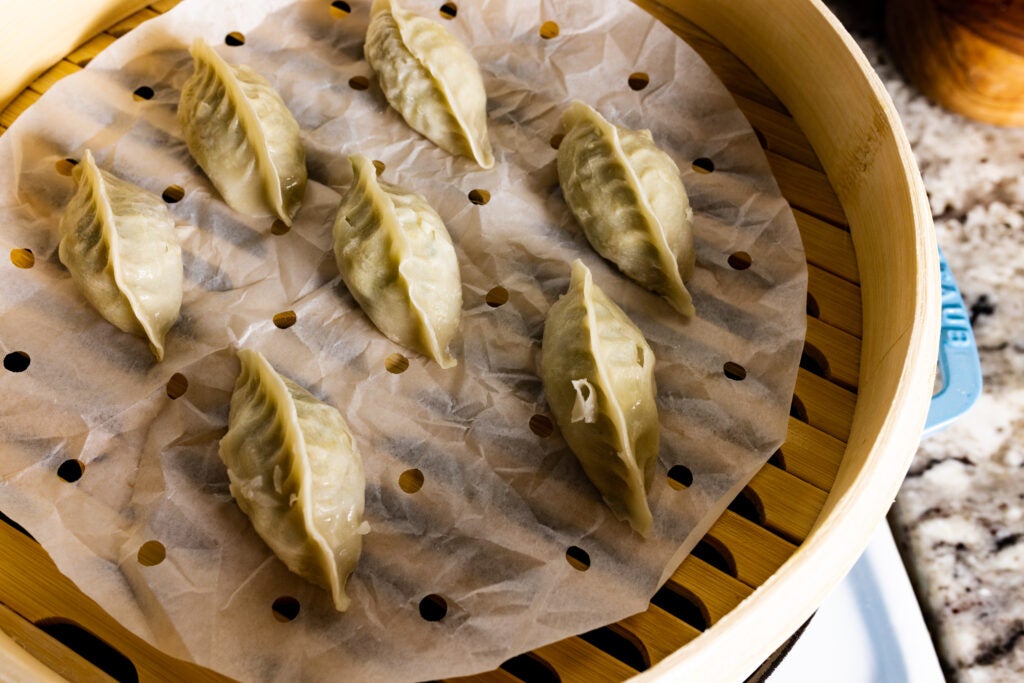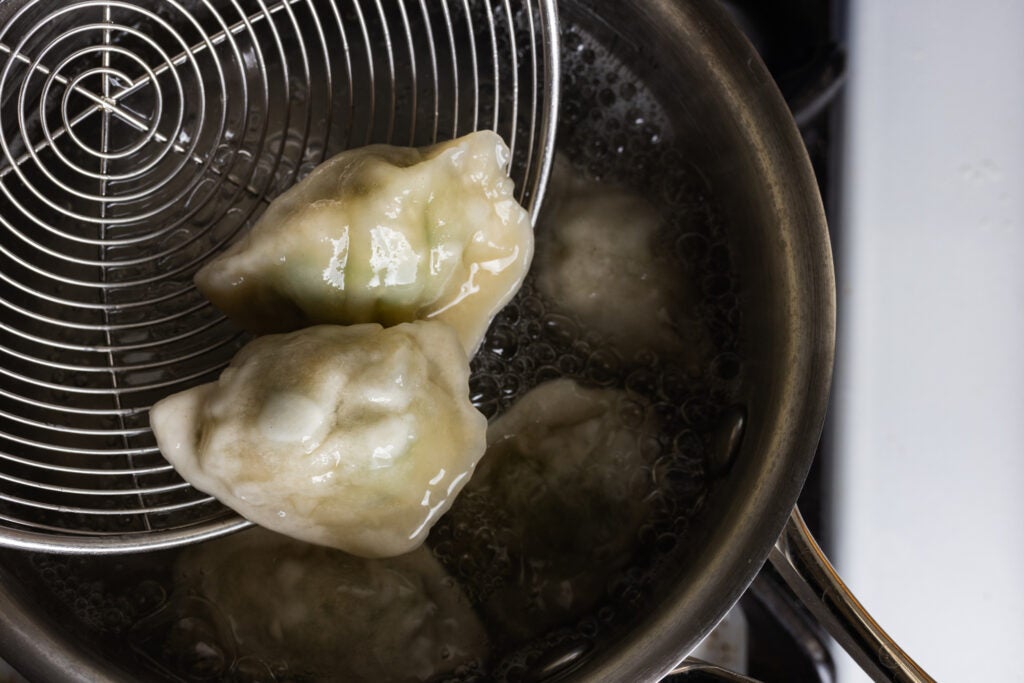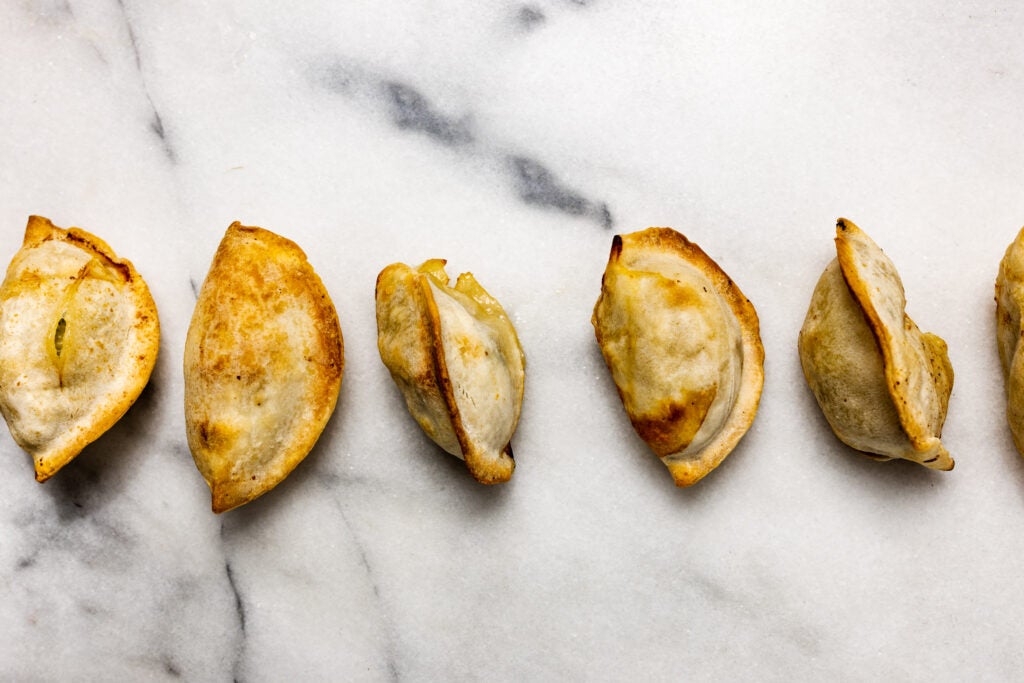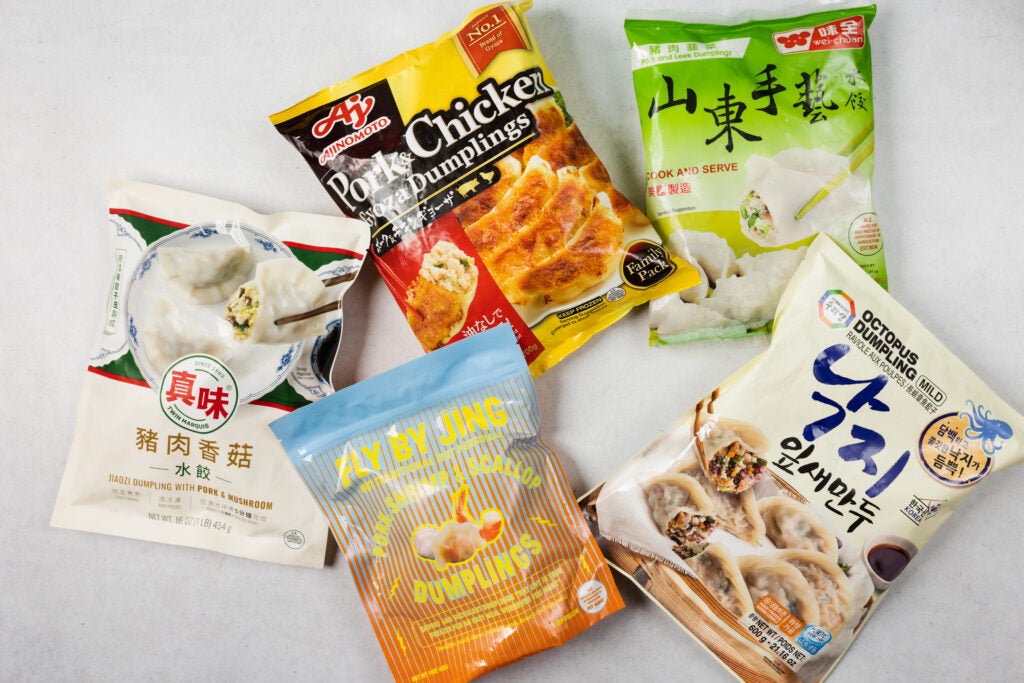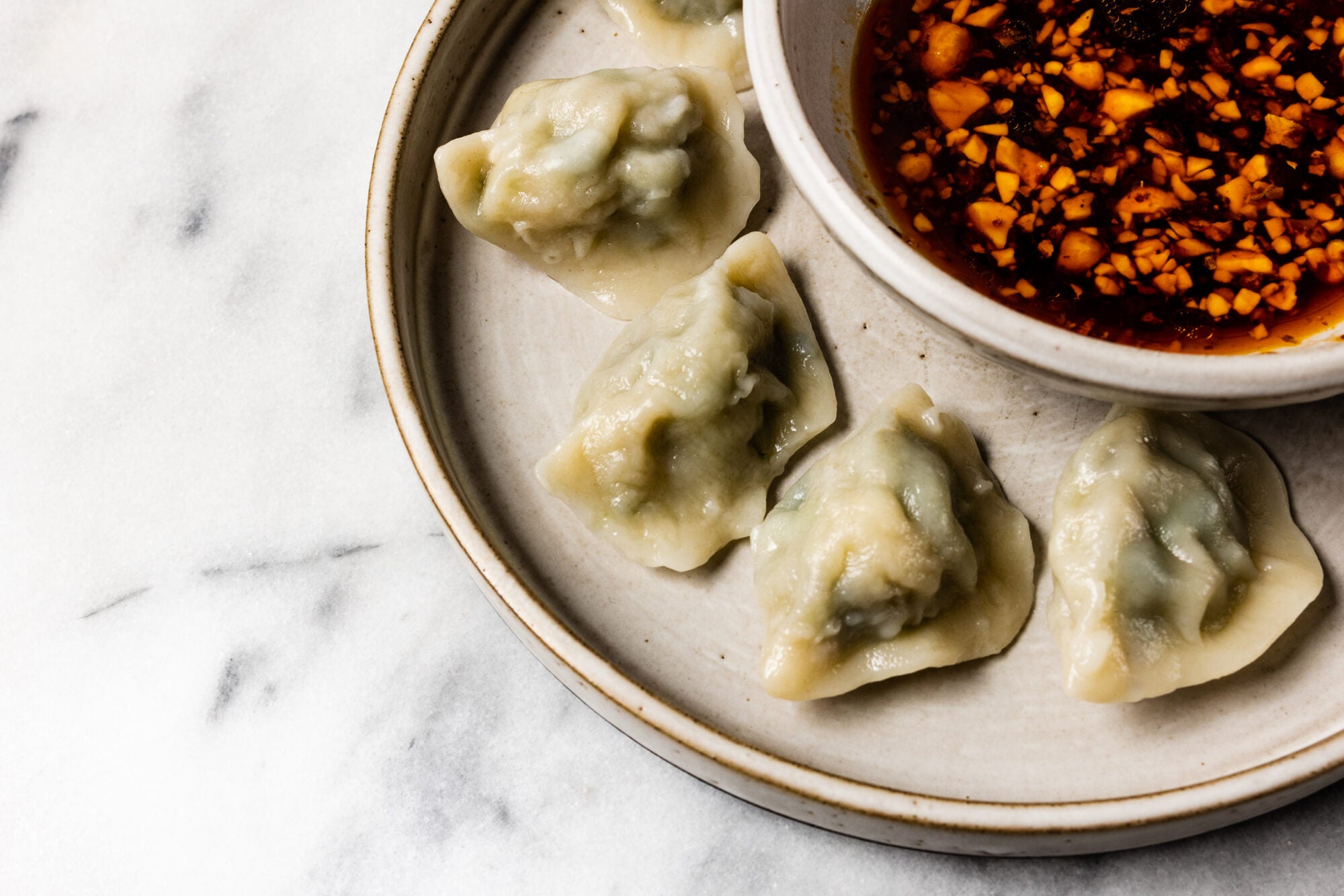
How to boil, steam, fry, and, most importantly, shop for frozen dumplings.
Frozen dumplings are my weeknight heroes. They are one of the most versatile ingredients I cook from my freezer, bringing maximum pleasure with minimal effort. Since high-quality dumplings (and there are a lot of them) are already stuffed with perfectly seasoned meat and vegetables, I don’t have to do as much to turn them into an impressive centerpiece. I can simmer pork and chive dumplings in broth to whip up a hearty soup in under 15 minutes, or I can panfry them with soy-sauce-seasoned eggs to make a quick donburi over rice. I can even jazz up my quesadillas by mixing chopped, steamed meaty dumplings into the mozzarella and pepper jack cheese.
I’ve never met a dumpling I didn’t like. There’s wrinkly kimchi mandu from Korea; flavorful, brothy xiaolongbao from China; crispy-bottomed gyoza from Japan; and even steamy chicken momos from Tibet. But the eating experience changes dramatically depending on how they are cooked. Some are better panfried than steamed, and others are designed to be air-fried. Matching each method with the right technique unlocks every dumpling’s juiciest full potential. Not sure where to start? Allow this dumpling nerd to walk you through all the possible ways to cook these versatile frozen weeknight heroes.
PAN FRY
I love panfrying dumplings because I can enjoy two completely different textures in one glorious bite: a soft, tender, juicy exterior and a crispy bottom. This method is ideal for dumplings with a larger surface area that touches the pan, such as gyoza, half-moon-shaped dumplings, and square-shaped ones.
The panfrying method starts with lightly frying dumplings in a generous splash of neutral oil, like canola or vegetable, then finishes the cooking process by creating intense steam from pouring liquid into the hot pan. Start by adding 1 or 2 tablespoons of neutral oil to a nonstick pan over medium-high heat. Using a nonstick pan is the easiest way to ensure that you can easily remove the crispy-bottomed dumplings, but if you don’t have one, just line the bottom of your pan with a circle of oiled parchment paper. I swear, it doesn’t burn!
Arrange the dumplings in a circular pattern or a line, ensuring the flat dumpling bottoms touch the pan but that their pleated, pinched tops don’t. Because frozen dumplings tend to have some residual ice crystals on them, I arrange the dumplings in the pan before the oil gets too hot, in order to avoid getting splattered with hot oil when the ice begins to melt. Cook for 2 to 4 minutes, or until the bottoms of the dumplings start to brown.
Carefully pour 3 to 4 tablespoons of water, depending on how many dumplings you’re cooking at once, into an area of the pan where there’s not too much oil to create the steam. (Be sure not to add water directly to hot oil. I learned this the hard way after almost burning down my New York City kitchen!) The water will begin to steam as soon as it hits the hot pan, so immediately cover the pan with a lid or a large sheet pan to finish cooking the dumplings while making them moist and juicy. Reduce the heat to medium-low and cook for 5 to 6 minutes, until the tops of the dumplings look moistened and steamed. If there’s still too much water in the pan, uncover the lid to allow most of it to evaporate.
How to add a crispy skirt
If you want to take your panfrying one step further, you can create a crunchy dumpling skirt by adding a starchy slurry at the steaming stage in the process. A slurry consists of water and starch, and the starch from a slurry creates a wonderful crunch after the moisture is cooked off. I like to mix 3 tablespoons of water with 2 teaspoons of starch, which can be anything from all-purpose flour to cornstarch, but the ratio doesn’t need to be exact, as long as the slurry is pourable. The skirt is cooked when you see crunchy brown bits form from the starch in the pan. To serve, cover the pan with a plate first, then flip the whole pan to perfectly showcase the crispy bottom.
DEEP-FRY
When dumplings get fried all around the surface with bubbles, they create a fantastic crunch, almost like fried chicken. Gyoza and half-moon-shaped dumplings are the best kinds for deep-frying because of the crispy folds.
Deep-fried dumplings are delightful to eat, but they can be a bit of a hassle to execute, especially at home. The trick is to heat enough neutral oil to around 350°F in a deep pot, like a Dutch oven, so that the dumplings can be completely submerged. It’s also crucial to thaw frozen dumplings before deep-frying them to remove ice crystals and avoid a painful oil splatter. Transfer them to the fridge overnight, or microwave for 30 seconds to remove any excess moisture before adding them to hot oil.
STEAM
Steamed dumplings have a slightly bouncy, delightfully chewy texture. I also think steaming allows the dumpling filling’s flavor to stand out more, since the moisture releases the natural juice of the fillings. I prefer to steam bigger, rounder soup dumplings to seal the juicy filling inside the bouncy dumpling skin before finishing them with a drizzle of chile crisp and a dash of soy sauce.
This method requires a steamer, which is a versatile addition to any kitchen. There’s no one shape of a steamer that’s superior, as long as the vessel allows steam to circulate and captures the moisture with a lid. I personally love using a stackable bamboo steamer, but a collapsible metal one works, too.
Once you have a steamer, find a pan or pot that’s the same or wider than the size of your steamer. Then, pour enough water into your pan or pot so that it’s boiling, but it doesn’t touch the steamer’s surface. I highly recommend adding a layer of parchment paper to the basket to keep the dumplings from sticking to it. Line your dumplings up, 1 inch apart, on a parchment-lined steamer basket, then put it atop boiling water in a pan or pot, close the lid, and steam on medium-high heat for anywhere from 7 to 10 minutes. Be sure to check the water level so that there’s enough simmering water remaining to create steam.
BOIL
I love to boil smaller wontons. Their soft, tender texture is more tender than when steamed, perfect for contrasting with a generous amount of chile crisp and fried shallots. Explaining this method feels like sharing a recipe on how to boil water, but there are a few tricks to boiling dumplings in order to achieve plump, wrinkly perfection.
First, you have to use a large, heavy-bottomed pot, preferably a wider one, so the dumplings can cook in a tornado of bubbling water without sticking to the sides. Fill the pot around two-thirds of the way full with unsalted water, then bring it to a boil over high heat until you see large bubbles. You can salt the water a little bit, but since boiled dumplings are often dressed with sauces at the end, I don’t think it’s necessary to season the water the way you do when cooking pasta. Add the dumplings to the boiling water and let them cook for a few minutes. When they float to the top, they are almost done. Fish them out, preferably using a slotted spoon, shake them off a few times to get rid of any excess moisture, and serve them straight onto the plate.
Here’s another easy way to enjoy boiled dumplings: dumpling soup! I boil the dumplings directly in a flavorful broth, such as chicken broth or instant beef bone broth, along with a few greens, like bok choy, and I can enjoy tender, boiled dumplings with delicious broth at once within minutes.
AIR-FRY
I’ve been talking about the pure joy of owning an air fryer since I bought one as a birthday gift a few years ago. The first thing I made as a test was a batch of frozen dumplings, and once I tasted beautifully brown and crisp dumplings with small bubbles around the edges, I was completely sold. I dare to say that air-frying is the easiest, tastiest method of cooking frozen dumplings. You don’t have to do anything besides pressing a few buttons.
I recommend spraying cooking oil, like PAM or Trader Joe’s olive oil spray, on frozen dumplings to enjoy a crackling, shattering, potato-chip-like crunchy texture. Nowadays, many frozen dumplings on the market have specific instructions for how to use an air fryer, with a temperature and cooking time, and some even recommend air-frying as the default cooking method with an air fryer symbol on the packaging. If your package doesn’t provide air-frying instructions, start at 350°F for 5 to 7 minutes, then check your dumplings’ doneness. And if you don’t have an air fryer, no worries.
A convection oven will work as well, set to 380ºF or higher for a crisp, brown texture. Line up the frozen dumplings in a parchment-lined sheet pan. Then, apply a little bit of neutral oil on the surface, preferably using an oil spray. Bake them in the pre-heated oven for 15 to 20 minutes, until they turn golden brown. I love pairing crispy, air-fried dumplings with saucy noodles, because the dumplings add a delightful crunch to the noodles—or I’ll serve them over warm rice with a fried egg, soy sauce, and a dollop of gochujang.
How to buy dumplings: Some of my favorite brands to stock in the freezer:
Bibigo Beef and Vegetable Dumplings
Bibigo mandu is my top choice when it comes to frozen dumplings. They have a variety of fillings, but I always find myself coming back to beef and vegetable ones. This one is perfect for all the methods above, but I especially love when they are air-fried.
Bibigo Crispy Rice Wrapper Dumplings with Meat and Vegetables
I love the square, flat shape of this particular dumpling. It’s ideal for panfrying.
Surasang Octopus Dumpling
I was skeptical about this chopped octopus filling, but the texture is so flavorful and juicy when steamed.
Pulmuone Juicy Pork and Kimchi Dumpling
This extra-large dumpling has a spicy, chopped kimchi filling, which I love. The pleasure of biting into freshly steamed kimchi dumplings is indescribable.
Pulmuone Pork and Leek Wontons
These wontons are fantastic when boiled. I love to cook them in instant beef broth with beaten eggs and lots of scallions to make a comforting soup in less than 10 minutes.
Olbaan Spicy Myeangran Mayo Dumplings
Myeongran, seasoned pollock roe, makes a beautiful, savory dumpling filling. It’s not fishy at all, and it’s slightly creamy, thanks to the addition of mayonnaise.
Wei-Chuan Pork and Leek Dumplings
Pork and leeks are a classic dumpling filling flavor pairing, and Wei-Chuan is a trusted brand that I rely on. They also offer various other flavors worth exploring, such as XO spicy pork, scallop, and shrimp; pork and fennel; pork, leek, and shrimp; and more. They are best when boiled.
Twin Marquis Jiaozi Dumpling with Pork and Mushroom
Twin Marquis is a brand that makes my favorite dumpling skin. It has a wonderful, slightly chewy bite, especially when steamed, and their fillings are slightly wonderfully seasoned and flavorful even without the dipping sauce.
Ajinomoto Pork and Chicken Gyoza
Gyoza tastes best when panfried, and this classic Japanese brand never lets me down.
Fly by Jing Pork XLB Soup Dumplings
Fly by Jing, a company known for its Sichuan chile crisp, has a line of delicious frozen soup dumplings. They are so flavorful, and they’re packed with aromatic, rich soup.
XCJ Shrimp and Pork Soup Dumplings
These xiaolongbao are packed with so much juice. The broth is rich without being too heavy, and the filling is well-seasoned but not overpowering.
